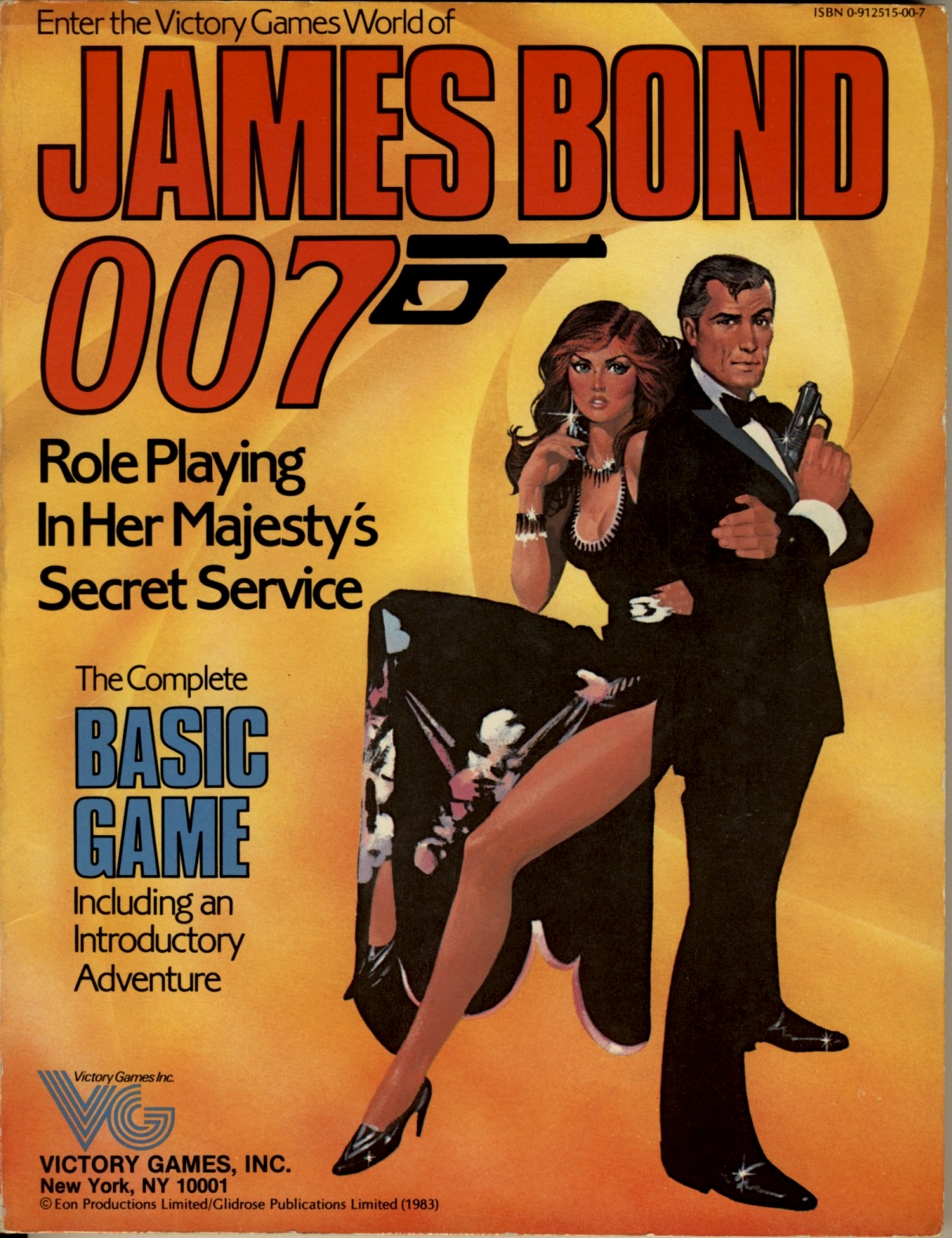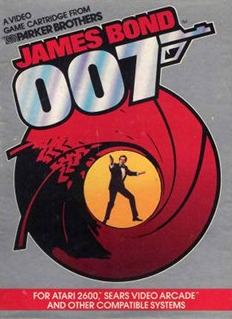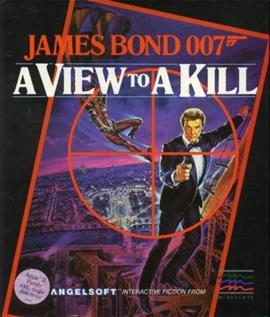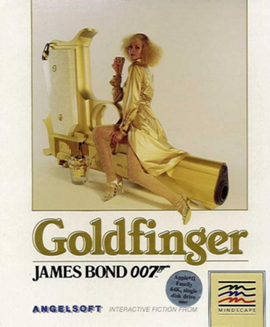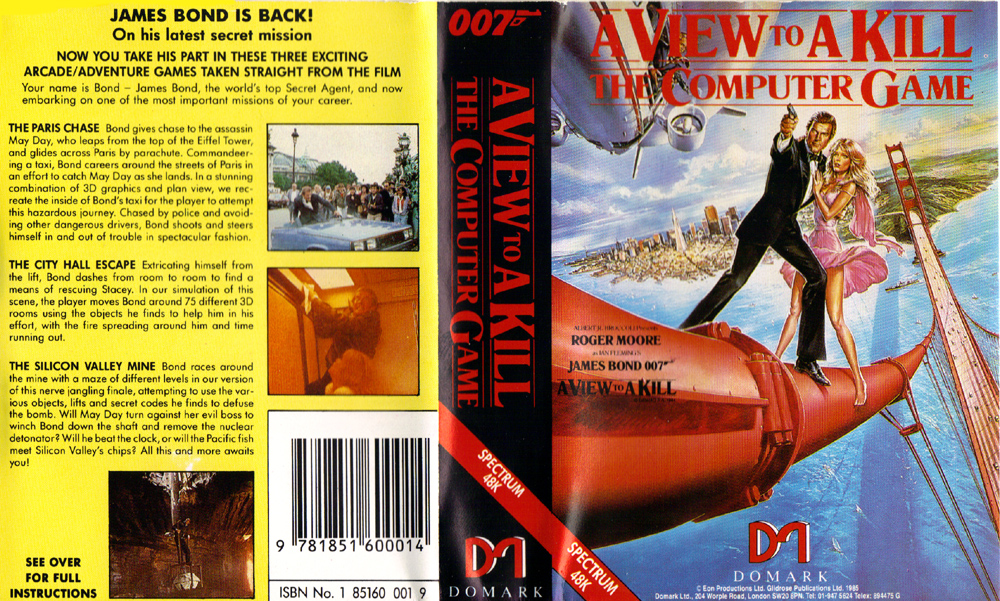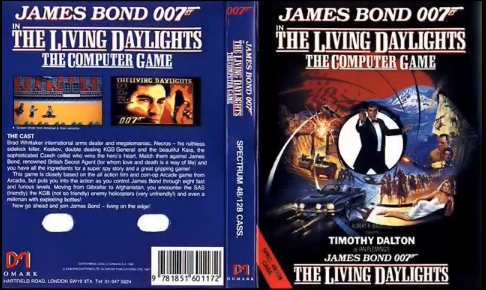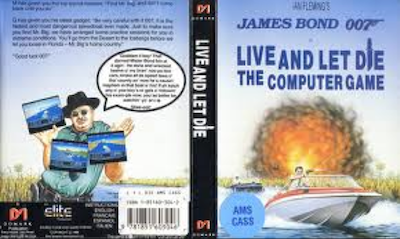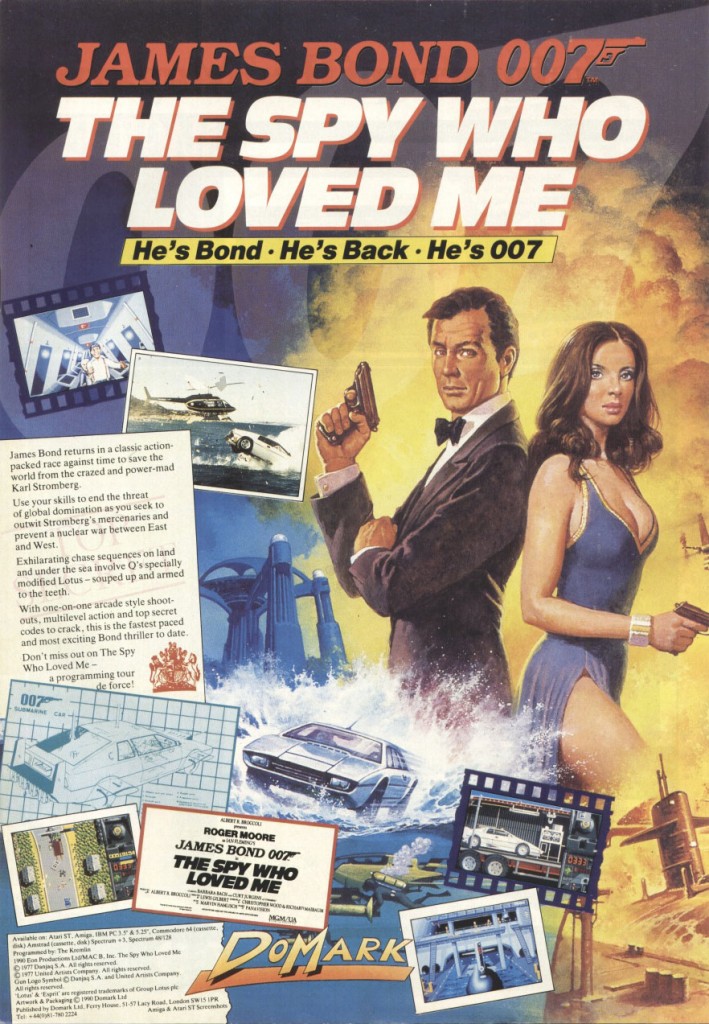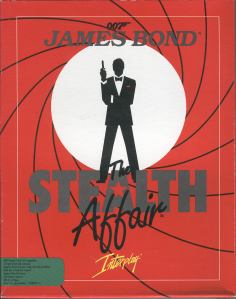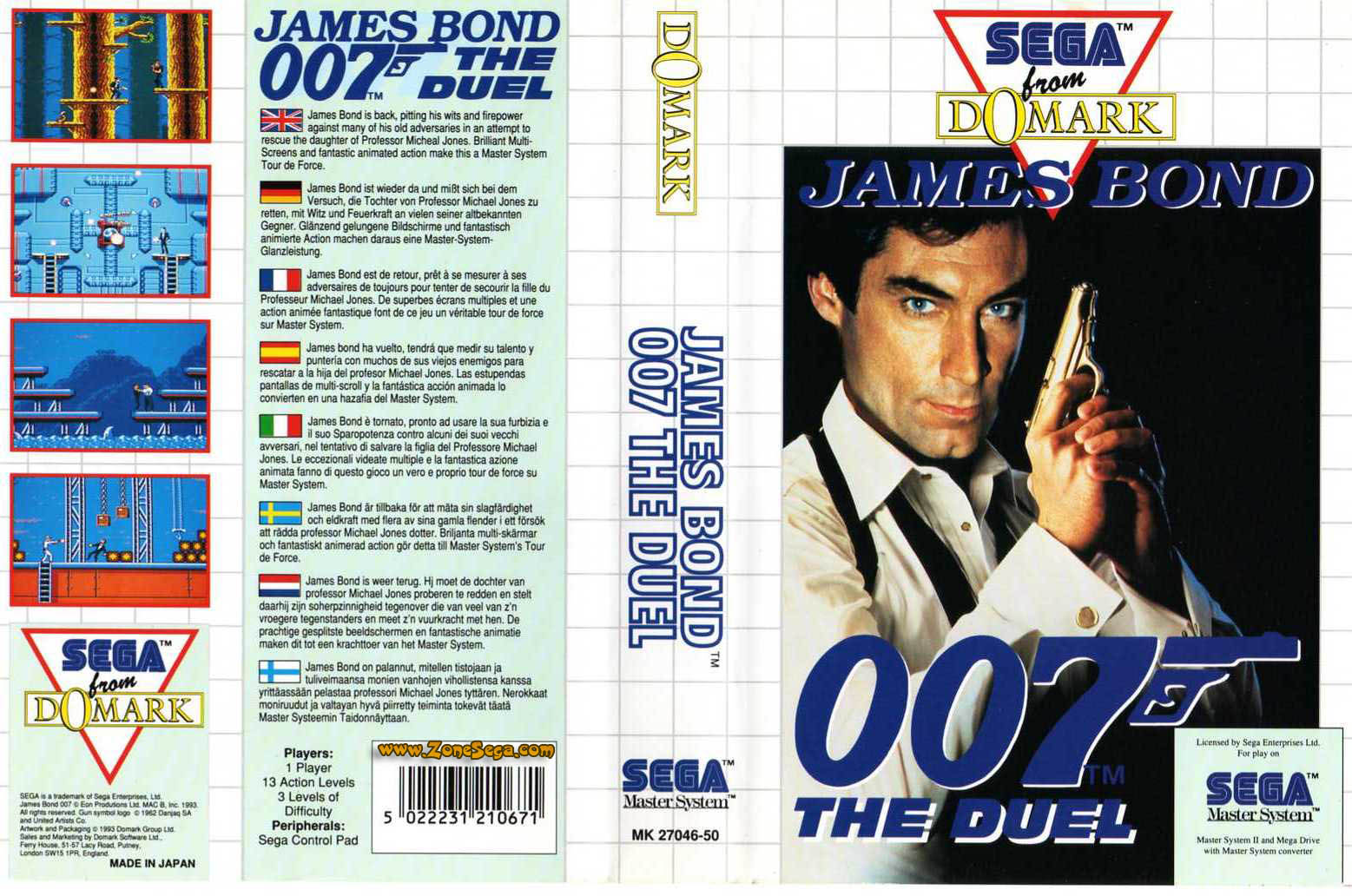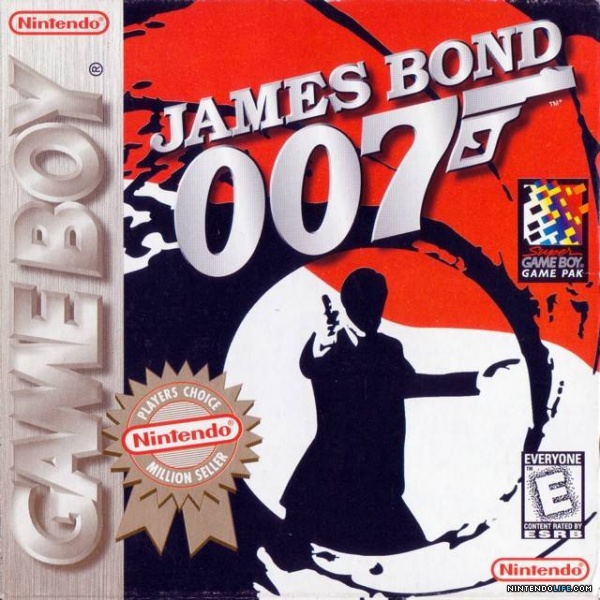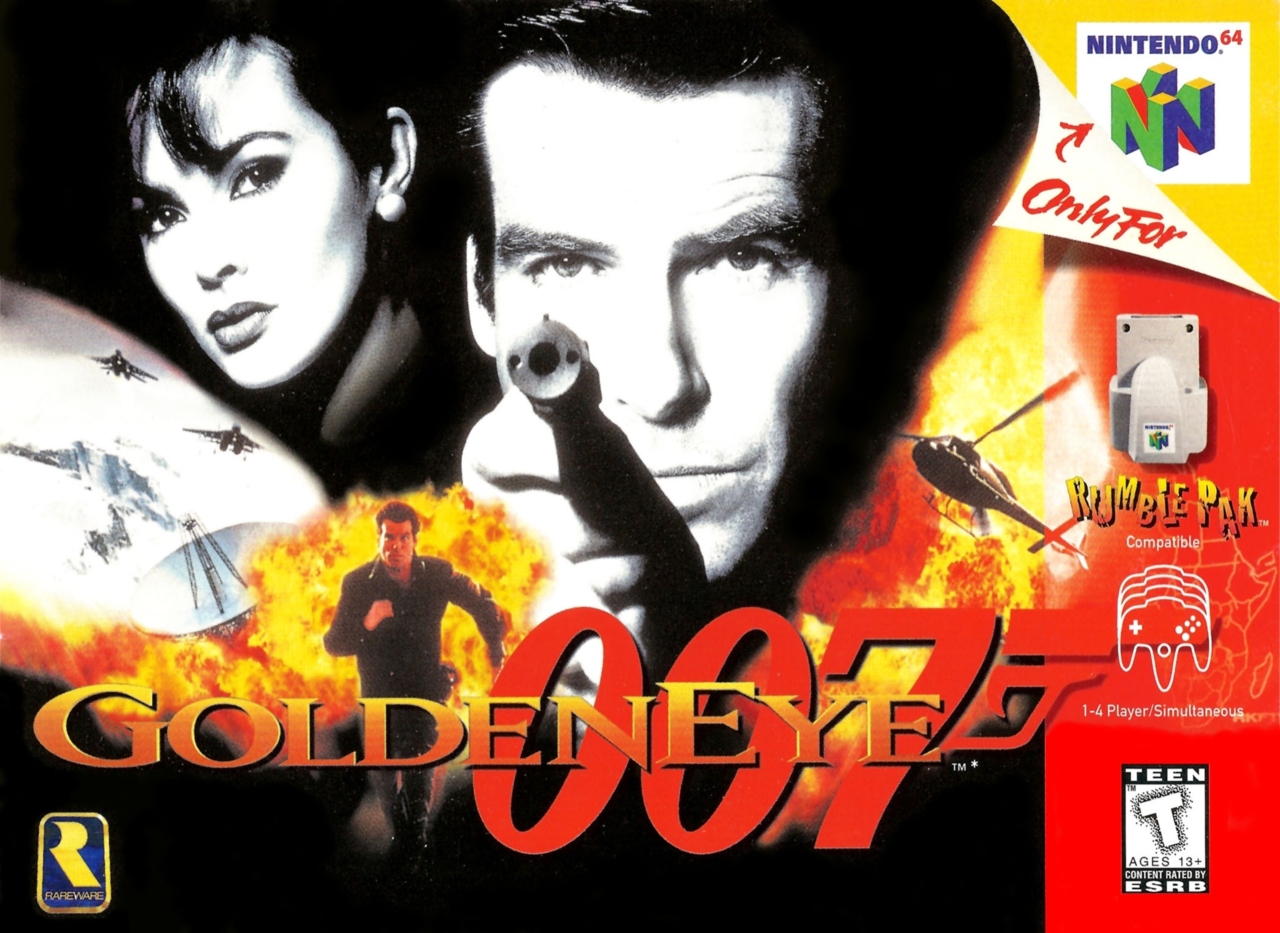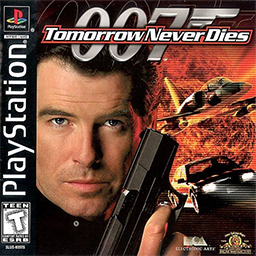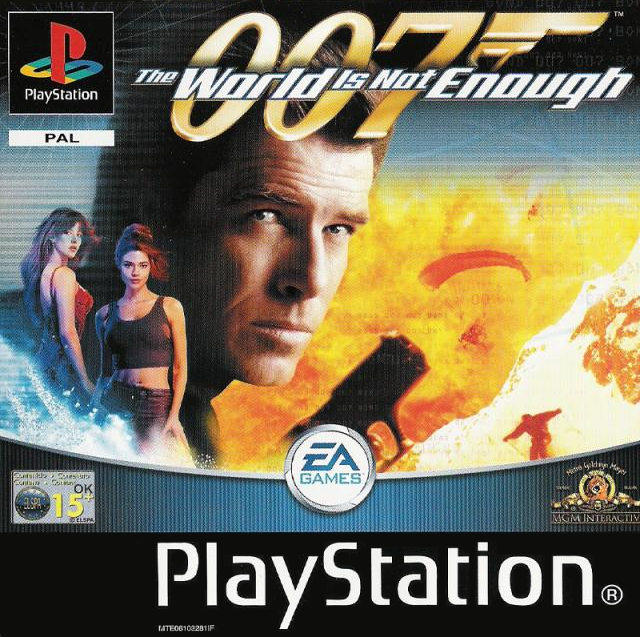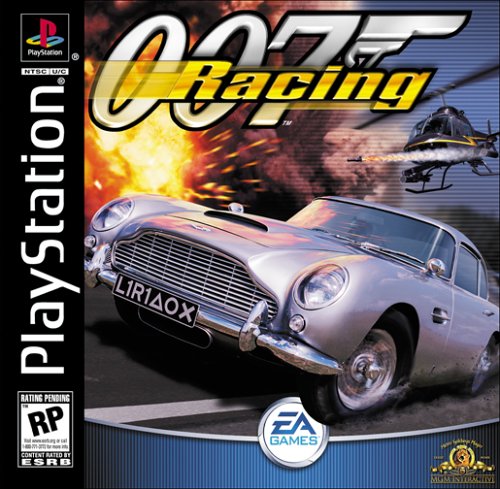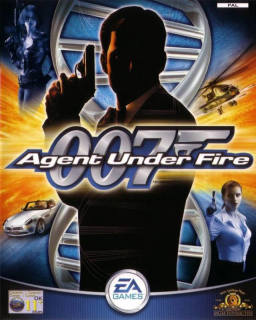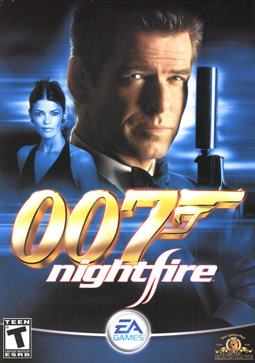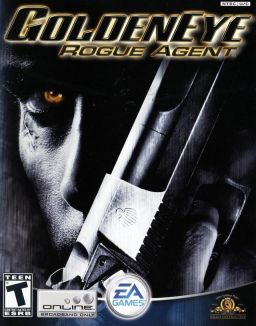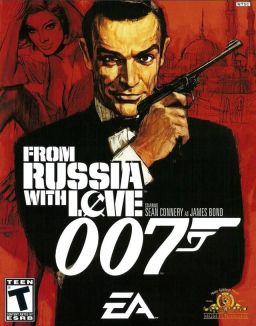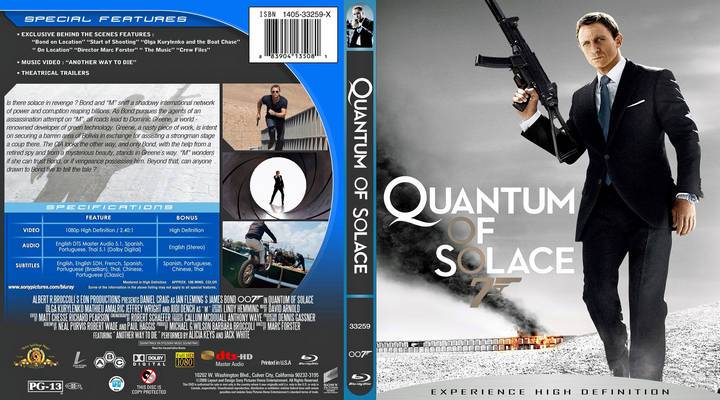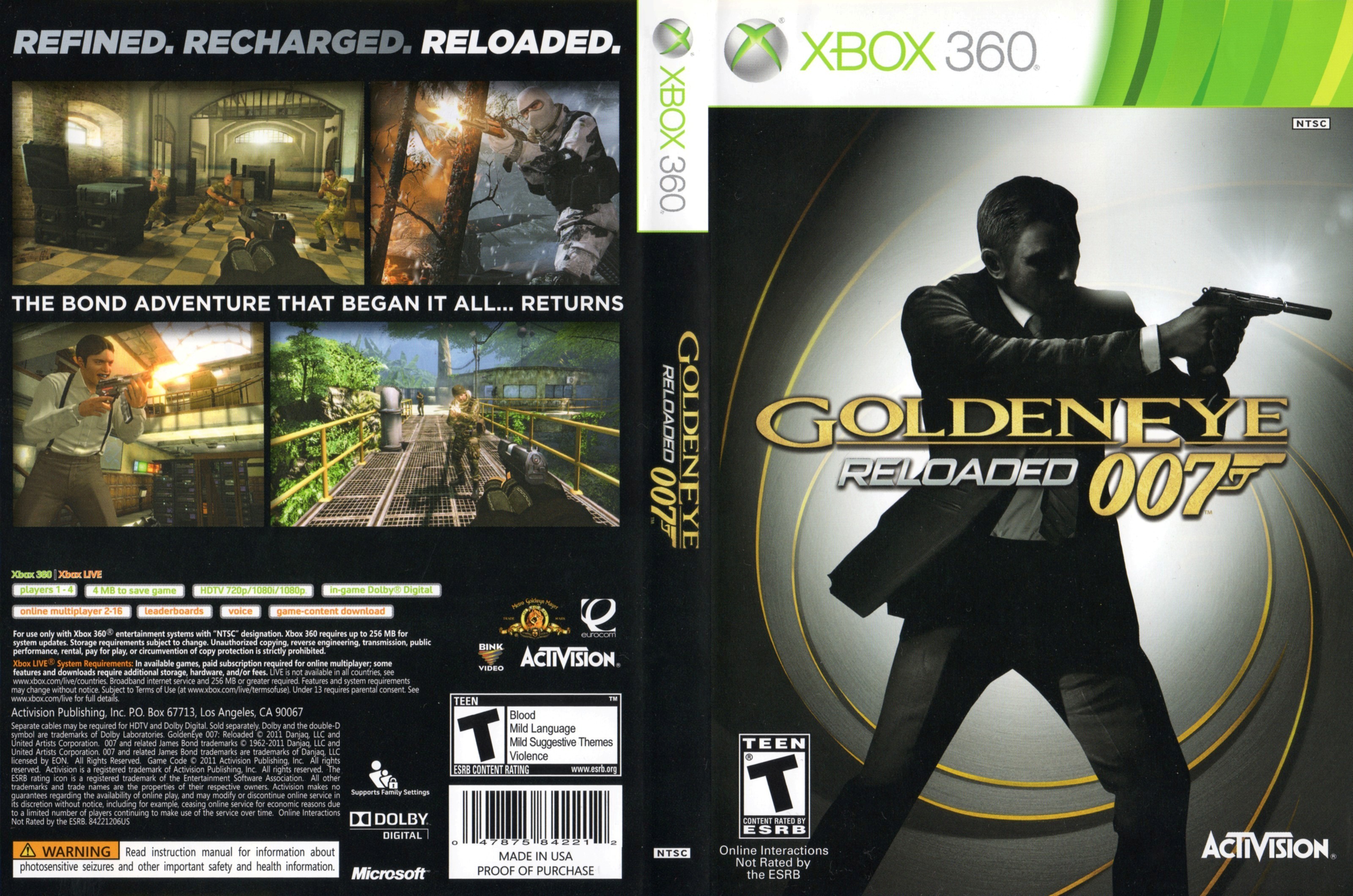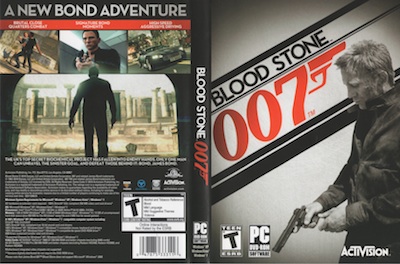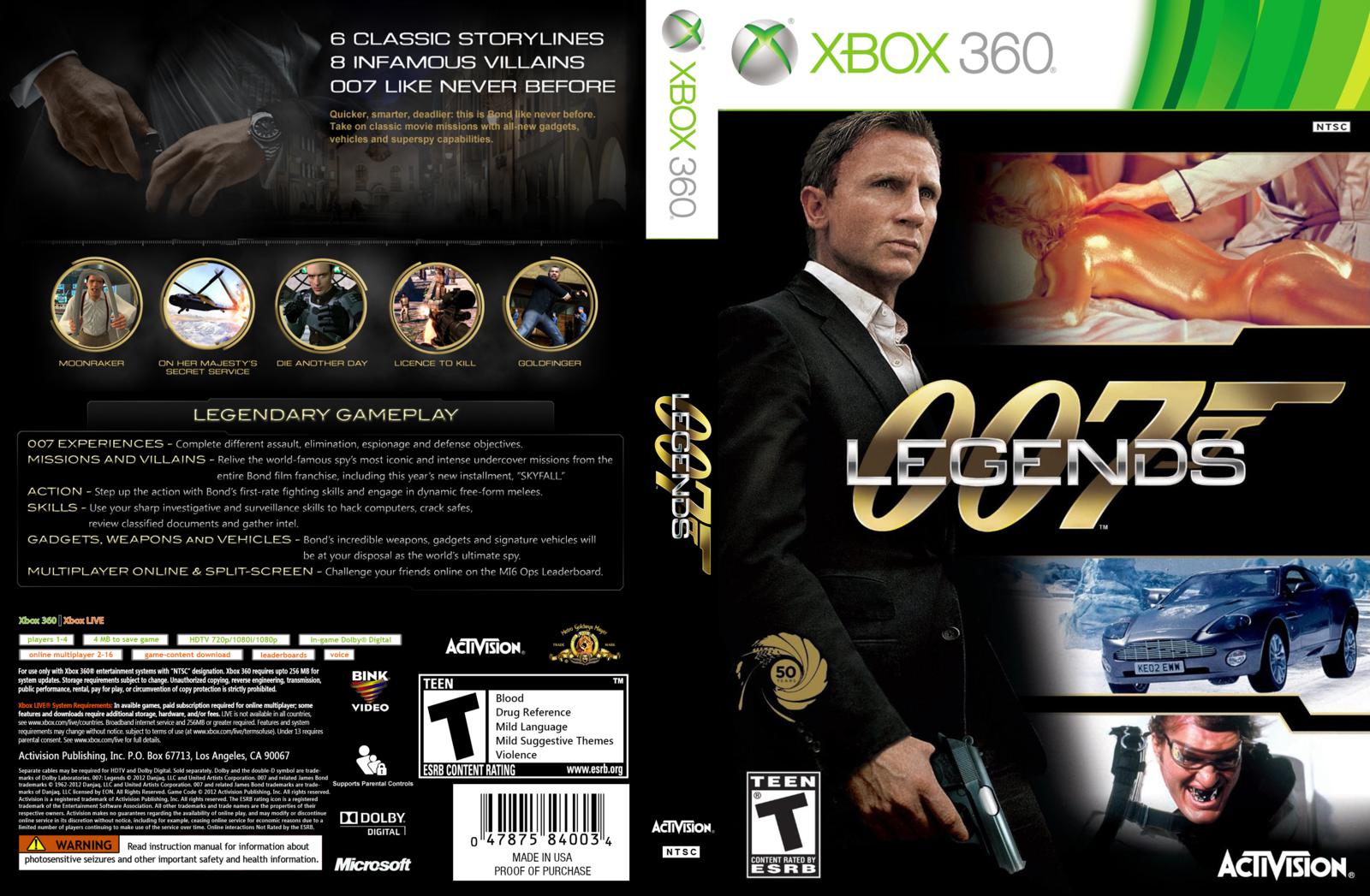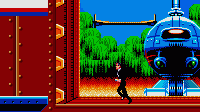GAMING
It used to be that 'gaming' meant putting on your best suit, and heading to the casino for a night of vodka martinis and Chemin de Fer. With the vast technological advances that have taken place in the last fifty years, however, it has evolved into staying at home in your boxer shorts and playing interactive games on TV from the couch.
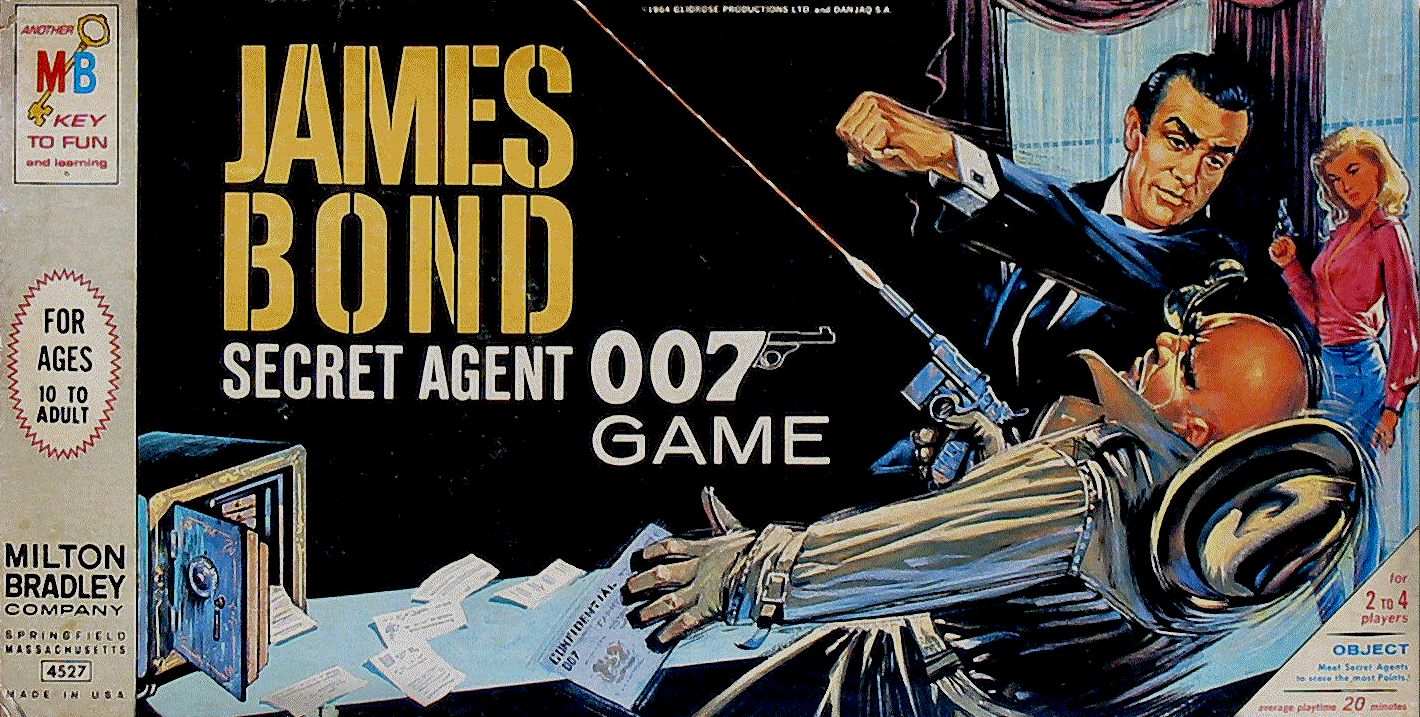
In the dark days of the 1960s and 1970s, Bond fans were relegated to board games, role-playing challenges, and just pretending in the back yard.
But in the 1980s, a tabletop James Bond role-playing game was introduced, in the tradition of Dungeons and Dragons, which became quite popular. James Bond 007: Roleplaying in her Majesty's Secret Service was designed by Gerard Christopher Klug, and published by Victory Games (a branch of Avalon Hill), based on the James Bond books and films. Players used 6 and 10-sided dice to determine what happened. The game, and many supplements, were published from 1983 until 1987, when the license lapsed. The characters from the Bond universe, including Bond himself, his allies and enemies, Anya Amasova, Jaws, Goldfinger, etc., play important roles. One notable exception was the villainous organization SPECTRE and its leader, Ernst Stavro Blofeld, the rights to which were contested by Kevin McClory, so in the game, they were replaced by a similar organization called T.A.R.O.T. (with a Tarot card theme), led by Karl Ferenc Skorpios.
The image of James Bond on the cover of the game box and supplements is intended to be a composite of actors Sean Connery and Roger Moore, who were each portraying James Bond in movies at the time of publication (in Octopussy and Never Say Never Again).
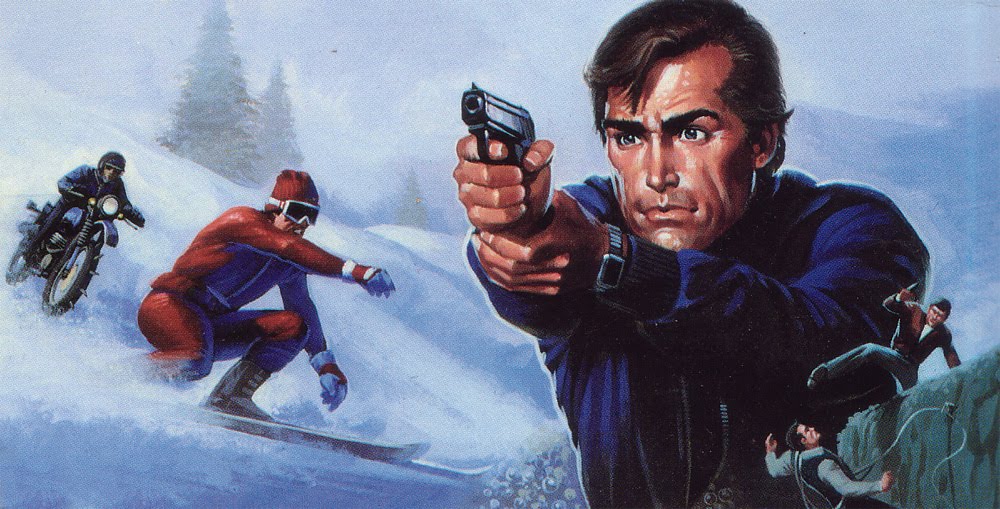
Most adventures were based on specific James Bond movies, with a few vital plot details changed, so players who had seen the film would still be surprised by the adventure. A few were written as sequels to earlier adventures based on specific movies.
Goldfinger (October 1983), based on the book and film.
Octopussy (October 1983), by Gerard Klug, based on the film.
Dr. No (1984), by Neil Randall, Gerry Klug, based on the book and film.
You Only Live Twice (1984), by Neil Randall, Gerry Klug, based on the film.
Live and Let Die (1984), based on the book and film.
Goldfinger II: The Man With The Midas Touch (1985), by Robert Kern - sequel to the Goldfinger adventure.
The Man with the Golden Gun (1985), by Brian H. Peterson, Gerry Klug, based on the film (Solitaire Game)
A View to a Kill (1985), by Gerard Christopher Klug, based on the film
You Only Live Twice II: Back of Beyond (1986), by Raymond Benson, Gerry Klug; a sequel to the You Only Live Twice adventure.
For Your Eyes Only (1986), by Robert Kern, Gerry Klug, based on the book and film.
On Her Majesty's Secret Service (1987), by David Spangler -- four linked solitaire adventures, based on the book and film.
Raymond Benson, co-author of the You Only Live Twice II: Back of Beyond adventure, went on to become the official author of the James Bond continuation novels for Glidrose Publications.
The game was considered successful, selling almost 100,000 copies and quickly taking over the status of most popular espionage role-playing game from Top Secret. It was also well supported with supplements by Victory Games. But Avalon Hill had trouble renewing the license from Danjaq in 1987, with each side blaming the other for unwillingness to continue, and the game ceased publication.
One reason for Danjaq's lack of enthusiasm may have been because a new form of gaming had taken over the market. With the advent of video games, a number of James Bond titles have appeared on multiple consoles since 1983, and have grown incredibly popular -- to the point that many of the writers and actors of the films have worked on the games, as well. In fact, over the last 25 years, you can see the growth in popularity, creativity and artistry that is nothing short of staggering. The Bond games during this period only worked on primitive systems like the Atari 2600, the Amstrad, the Amiga, and the Commodore 64. Given the technical limitations, most of the titles focused on racing or shooting -- simplifying the stories, increasing the action, and making the characters less complex -- much the way that filmmakers at EON adapted Fleming's books.
The first official game released in the James Bond video game series was back in 1983, a side-scrolling action game developed by Parker Brothers (known more for board games than video games) for the Atari 2600, Atari 5200, ColecoVision, and Commodore 64. It was simply named James Bond 007, in which players controled Bond's amphibious Lotus (or Aston Martin... hard to tell) to clear four movie-inspired stages, based on Diamonds Are Forever, Moonraker, For Your Eyes Only and The Spy Who Loved Me. If you're looking for suspense and decent graphics, buy a comic book instead. The only real suspense was whether the game was going to freeze up on you or not before you got to the next level.
The aim of the game was to shoot airbourne and grounded enemies while dodging their incredibly slow-moving attacks and avoiding obstacles. Later it was revealed that the game started out as a movie-tie in for Octopussy before someone quietly recycled it into this mess. (Why not? You can't tell what's happening, anyway.) When a player's last life is lost, M bids James goodbye, and the final score is shown.
Shortly after the game was released in 1983, Parker Brothers announced another video game in magazine ads t-- once again announcing it would be called Octopussy, based on the film of the same name, and scheduled for 1983 summer release. Then, once again, the project was cancelled for unknown reasons. Apparently, like Sean Connery, they decided to say "never" again.
That same year, Mindscape published a PC-only version of A View To a Kill, a text adventure in the style of Infocom developed by Angelsoft, Inc., for computers running DOS, Macintosh, and Apple II. Though it follows the movie somewhat, it took liberties with the plot to stretch it into new situations for the player to solve. (For instance the puzzle of, "Why did I buy this?") It was also possible to fail the game by not doing things quickly enough. (Hey, James Bond was sixty in this movie -- how fast could he really be?)
The game was written by Raymond Benson, who had successfully transitioned from table-top role-play games to computer-based games -- and would go on to write many James Bond continuation novels as a full-fledged author of books. Thanks to one legitimate author's respect for the words of original novelist whose work he would be continuing, this game is the most literate computer game you'll ever read, and Benson knows how to flesh out the characters (in some instances, better than the filmmakers). You're on the clock in this game, as well, so typos will cost you time, so without the time limit, I'd still be playing 30 years later...
007 Car Chase (1985) was a clone of Bally Midway's Spy Hunter (and several of its platform ports) had the player portray Bond in a car, possibly an Aston Martin, possibly a colored box, armed with machine guns and a smokescreen to blow up enemy vehicles while avoiding the opposition. It made you long for the high-tech artistry of Parker Brothers.
James Bond 007: Goldfinger (1986) was played on MS-DOS.
It was another PC-only release like A View to a Kill, a text-based video game developed by Angelsoft, Inc and published by Mindscape, Inc. for computers PC, Macintosh, and Apple II. There were no graphics in this game, as it was a text-based game. Word prompts would appear and the player could type in actions for Bond to perform.
This one is thinly based on the plot of the film Goldfinger, with changes made to simplify the story (probably because of deadlines more than interactive possibilities). The text was yellow (like gold, I'm guessing). Like many text adventures it suffers in needing commands that are too word-specific, i.e., 'use gun' doesn't work, but 'fire gun' does. The plot doesn't quite follow the film -- there's no duel with Oddjob, or even a setpiece at Fort Knox, and no laser torture scene (unless you screw up and get caught, like in the film). They've even neglected to give Bond a gun for the duration of the game!
To top that off, it even rewrites the ending:
Domark Games (1984-1995) then published a number of arcade-style James Bond 007 licensed games during the late 1980's (the company was named after its founders, whose names, obviously, were Dominic and Mark (Dominic Wheatly and Mark Strachan) -- which gives you an idea of the creativity coming out of those offices).
The first, 1985's A View To A Kill, was the first Bond game named after a specific film, and featured 3 sections. The first had James Bond attempting to pick up Mayday who had just parachuted from the Eiffel Tower, by carefully positioning his car for her to land on. Next was "The Mine," which consisted of a huge, side-scrolling maze of tunnels and caves. Finally, "City Hall" put you in a series of rooms and made you find Stacy (Tanya Roberts in the film) before the place burned down (Most Bond fans were rooting for him not to find her). It was considered a dismal effort that suffered bad publicity because it was riddled with bugs. In response, Domark spent a year looking for quality developers who wouldn't make the same mistakes on their next game.
1987's James Bond: The Living Daylights was a video game adaptation of the 1987 film. Domark finally used three different developers: Sculptured Software Inc (C64), Walking Circle (Spectrum), and De Re Software (Atari) to create slightly different versions of the same design by Richard Naylor. The game followed a rather tanned looking Bond traversing rooftops and fighting Soviet foes in Afghanistan ("Watch out James! He's throwing... milk bottles... very slowly!!!") Originally planned for a June 1987 release to coincide with movie premiere, The Living Daylights slipped a few months and was eventually released in September.
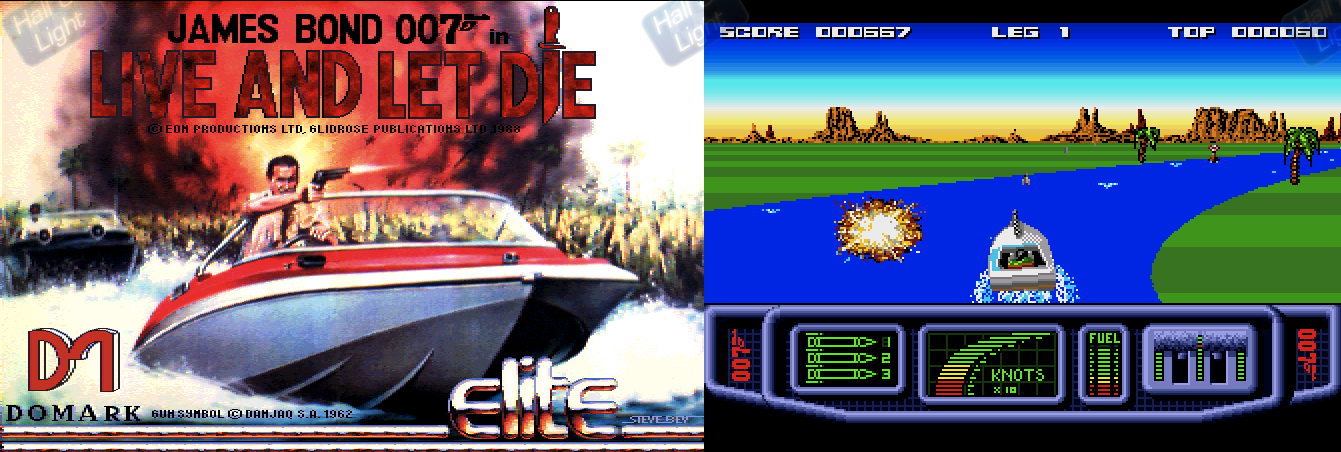
The Living Daylights was enough of an improvement that they were able to go on and produce Live And Let Die (1988), which actually wasn't intended to be a Bond game at all. It was originally titled, "Aquablast," but rebranded when Domark realized the resemblance of their generic game to the film's high speed boat chase (as was usually the case with Domark, the conflict was in the idea, not in the artistry of the execution). Live and Let Die was all about dodging obstacles and shooting up enemy boats, featuring levels in the Sahara, New Orleans and the North Pole. (Just like the movie, right?) The comparison above compares the excitement on the cover of a breathtakingly fast Louisiana bayou chase vs. the sad reality contained inside the box.

In April 1989 -- two months before the film opened -- the computer game adaptation of Licence To Kill hit store shelves for IBM PC, Amiga 500/600, Commodore C64/128, Spectrum 48K, Amstrad CPC, Atari 8-bit and Atari ST. It is a suprisingly varied top down shooter, as Bond tries to avenge the death of Mrs. Felix Leiter, and hunt down the killer and drug baron Sanchez. It takes you through 6 scenes from the film, using helicopters, by foot, mid-air, underwater, behind the wheels of a tanker truck, and most memorably (at least in the film) on water-skis. The game was also developed for the Nintendo Entertainment System (NES) by Tengen, but was unreleased as the Domark publishers felt that too much time had passed since the film's release and so the game would be irrelevant. But unlike the movie, the game proved more successful than other recent 007 outings, receiving positive reviews and selling well above expectations across all platforms.
There was a six year lull between the films Licence To Kill in 1989 and GoldenEye in 1995... but that didn't stop Domark from taking a character considered dead and buried... and digging a deeper grave.
In 1990, their next computer game went back in time and focused on a Roger Moore movie from 1977, The Spy Who Loved Me, and like Live and Let Die before it, this game largely ignored the plot of the film. It featured a synthy version of the James Bond theme (groovy), and was a top-down shooter game, in which you guide the famous aquatic Lotus Espirit through varied obstacles, taking out anyone in your path. Bond's Lotus careened through dangerous chases leading up to an underwater shoot-em-up with a four-way missile system. You even had to cover the bomb used to break into an enemy control room, then save Agent XXX on a jet ski while evading the attacking enemy hovercraft. If you hadn't seen the movie, it wouldn't have made any sense (not that it made much sense in the film, either).
The game received a good, but not excellent, reaction on the ZX Spectrum, with CRASH! giving it a 79% rating and saying "Good Mr. Bond, but not quite good enough to deserve an accolade." Sinclair User gave it 72% and said, "This one will leave you shaken but not stirred; A competent movie licence." Your Sinclair rated it at 76%, saying "Half good/half bad Bond game. There's quite a lot here though, so it's not bad value." It was less well received on the Commodore 64, with Zzap!64 giving it a rating of 38%, describing it as "an uninspiring and unambitious conversion."
The PC DOS version of the game suffered poor sales and high returns, so much so that developers The Kremlin recycled The Spy Who Loved Me 3.5" floppys as blank discs.
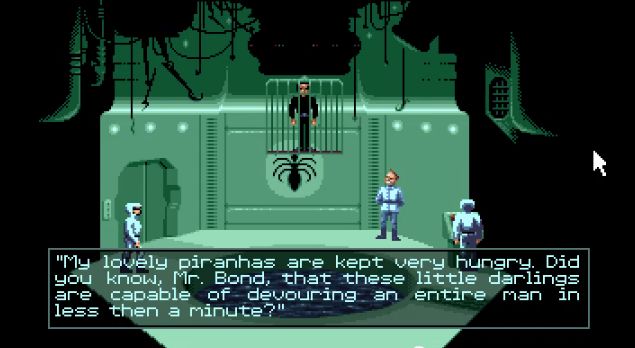
James Bond 007: The Stealth Affair (as it was known in the United States; in Europe it was called Operation Stealth) was released in 1990, as well -- but not done by Domark, but by Delphine Software International. The game is mainly the work of Paul Cuisset (programming) and Jean Baudlot (sound). The story revolved around a missing F-19 stealth fighter, stolen from an American base and tracked to Latin America. Who did it? Could it be the Russians pulling a Red October or could it be some Latin American tinpot dictator or crime lord? The danger of having a Latin American drug lord having stealth technology was sufficient to bring in the top secret agent in the business: James Bond... or was that John Glames? You see, The Stealth Affair was a James Bond adventure game in name only. It was originally released in Europe as Operation Stealth, and it wasn't James Bond who was tracking the bad guys, but agent John Glames of the CIA. How did this happen? Well, Interplay Productions -- the publisher who distributed Delphine's games -- acquired the James Bond license, then changed from a generic spy adventure game to playing 007 of Her Majesty's Secret Service. The bad French to English game text was reworded, and the story was streamlined to align to the Bondian universe. The game simply begged for Timothy Dalton or Sean Connery to do voiceovers, but, alas, the IBM PC version lacked digitized voices. However, the Amiga version had synthesized voices (with 1 MB or higher RAM), but a serious bug in the code would lead to a full system crash if the player tried to click through with the mouse button. Still, nobody would have known... except they had James Bond working for the CIA in Washington DC. Oops... Released on three formats in North America: IBM PC (MS-DOS), Amiga, and Atari ST. A review in the May 1991 issue of Compute!, noted, "Controlled by either keyboard or mouse, the Bond of The STEALTH Affair moves and acts in a manner like that of his namesake in latter-day 007 movies -- that is, choppy and silly, trading the quiet sophistication of Ian Fleming's hero for a goofy nonchalance." It was the last Bond title for Interplay, and Domark was back making Bond games in 1991...
James Bond, Jr. (1991) appeared in stores after the children's TV show that it was based on was already canceled. It opened with the hammy line "the world's greatest scientists have disappeared and now it's up to you as James Bond Jr to rescue them! Intelligence reports indicates that your old enemy SCUM Lord has imprisoned them on his island fortress in the Caribbean." SCUM in this case refers to Saboteurs and Criminals United in Mayhem and was an offshoot of SPECTRE. Published by THQ and based on the cartoon series of the same name, this showed up on both the NES and SNES. Players took on the role of James Bond Jr., nephew of the famous super spy, whose Saturday morning, kid friendly exploits, pit him against a green-skinned Dr. No and other re-imagined villains making up the forces of S.C.U.M. while balancing schoolwork and student rivalries at Warfield Academy, like most kids. He battles obstacles like snakes -- which he can only kill by using grenades to blow them up. Come on -- is that really the best way to avoid a snake?
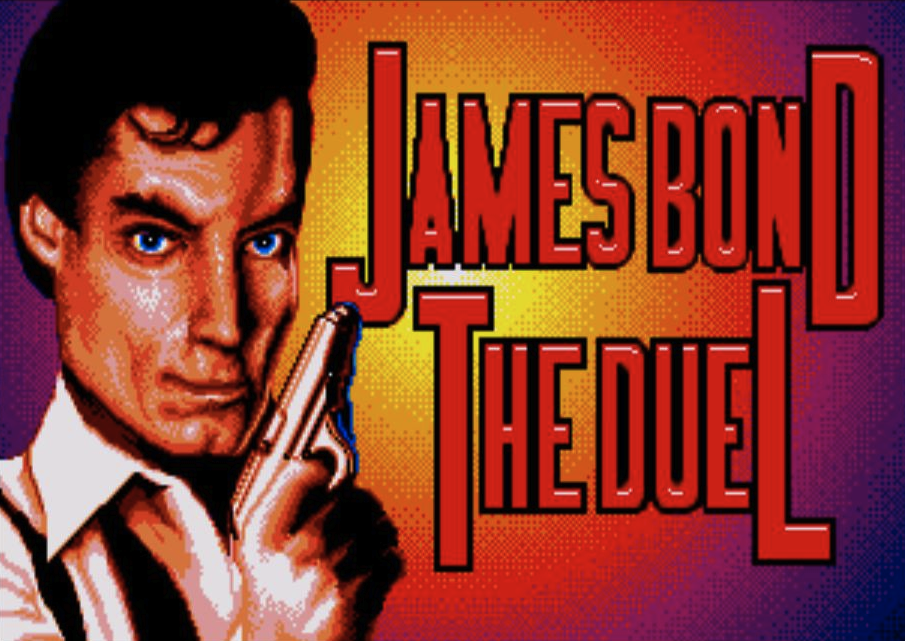
Ever wonder why Timothy Daltom never allowd comic book companies to use his likeness as James Bond? Look no further than the main screen of the above game, James Bond: The Duel (1993). Domark released this game (a.k.a. 007 Shitou in Japan, meaning "struggle to the death"), a side-scroller, in which Bond arrives by jetpack and battles his way through enemy bases, battling Jaws from the Roger Moore films, to rescue female hostages. The game was the first in the Bond catalogue not to be based on an existing film or book, and although it was released four years after his last appearance as 007, the game features Timothy Dalton's likeness. The plot involved a scientist bent on launching killer satellites into space, and he'd cloned supervillains like Live and Let Die's Baron Samedi and Dr. No to help him do it. It wasn't only Dalton's last appearance in the Bond franchise, it was Domark's, as well. The company no longer exists -- it was sold off and is now part of the Eidos video game company, and EON found new, better publishers.
Nintendo's James Bond 007 (1997), released a decade and a half after their original game, was a top-down shooter for the Nintendo Game Boy that has little in common with the other games listed here. Its developers Saffire chose not to try too much in the way of action on the modest Gameboy hardware. In this version, James Bond travels the world in an attempt to find out the secret behind General Golgov's plans, facing characters like Oddjob and Jaws. Bond also gets to flirt with Miss Moneypenny, receive a mission briefing from M and even pay a visit to Q's laboratory where they can pick up gadgets -- aspects of Bond lore that had been missing from the video game series. Bond must use items at the appropriate place and time to either sneak past impossible odds or to solve a mission. Players can save up to three games and/or delete them like Zelda games. Without weapons, player can either result to fists or karate moves. Players control Bond as he scours the various levels for different items to aid him in his mission. For instance: the sprawling black market level in Marrakech. Bond buys a cooked chicken from one of the vendors, uses it to acquire a cat which is then given to a trader whose stall is overrun by rats. (I think that was a scene in Casino Royale, right? Action-packed.) It also incorporated gambling mini-games such as Baccarat, Red Dog and Blackjack. It was covered in a 1998 issue of Nintendo Power being one of the last Game Boy games to be released in the 20th century. In addition to top-down action, players solved puzzles, collected items, and met people from multiple James Bond films, ranging from M to Oddjob. The RPG-like elements offered a surprising twist to the normally action-heavy portrayal... and he kills Jaws! Anyway, it was quickly forgotten, because it came out the same time as...
GoldenEye 007 (1997) revolutionized the video game industry. The Bond franchise had what many consider its greatest success with the release of this first-person shooter for the Nintendo 64. It is the third-best-selling N64 title ever (and the only one of those three to not have "Mario" in the title.) Developed by Rareware (then just "Rare") and published by Nintendo, it was based on the movie of the same name. The game loosely followed the film's plot, but also introduced old-school Bond villains like Oddjob, Jaws, Mayday, and Baron Samedi as playable characters, to introduce youngsters to the back-catalog, as well as interest older fans who didn't care as much about the new Bond. It's best remembered for its breakthrough four-player multiplayer modes. It was both a crucial milestone in the evolution of first-person shooters on consoles and universally considered one of the best movie license games ever made. Originally, it was planned that you could be one of four James Bonds (Connery, Moore, Dalton or Brosnan, but no Lazenby). This feature was later removed due to licensing issues, although shots of different bonds did appear in the game manual and TV commercial (showing the four Bonds battling each other):
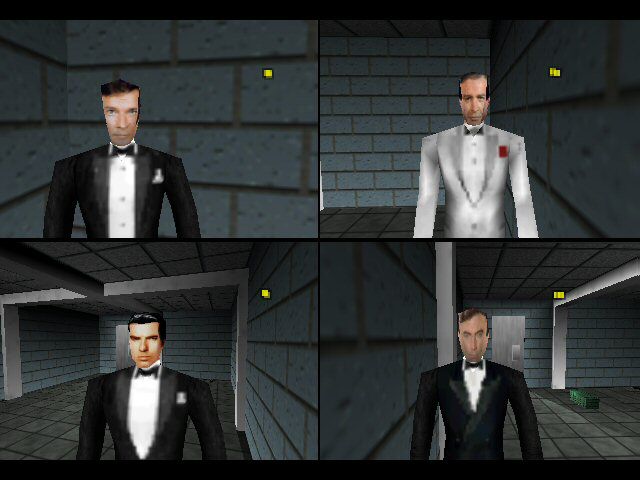
Electonic Arts (EA) Games then took over the license, with the release of its 1999 PlayStation title Tomorrow Never Dies. Developed by Black Ops, Tomorrow Never Dies tried and failed to live up to the standard set by GoldenEye. This game marks the fourth appearance of Pierce Brosnan's James Bond, although the voice of Bond is provided by actor Adam Blackwood in the game. The first mission ends with a scene taken straight out of The Spy Who Loved Me, however, as Bond skied off a cliff before deploying a union jack parachute. Unlike GoldenEye, the action in Tomorrow Never Dies was viewed from third person perspective and offered no multiplayer mode. A companion CD, Tomorrow Never Dies: The Original Score to the Video Game, was released alongside the game and featured much of composer Tommy Tallarico's musical score. Also included was the song "Letter to Paris" featuring vocalist Elaine Paiva.
One of the loading screens shows a level set on the HMS Devonshire, which was in the movie but cut from the game. There is speculation that other unused content may have survived from an earlier, cancelled game called Tomorrow Never Dies: The Mission Continues. There are, unfortunately, no real remnants left in the game to make these playable. But, as a bonus, you can play as other characters. By swapping the .TEX and .GUY files of a character with those of James Bond for each level (e.g. WAILIN22.GUY with BND05F11.GUY) will result in you playing as that avatar. Here is Paris Carver as Bond -- unfortunately she's not too good at holding onto her gun:
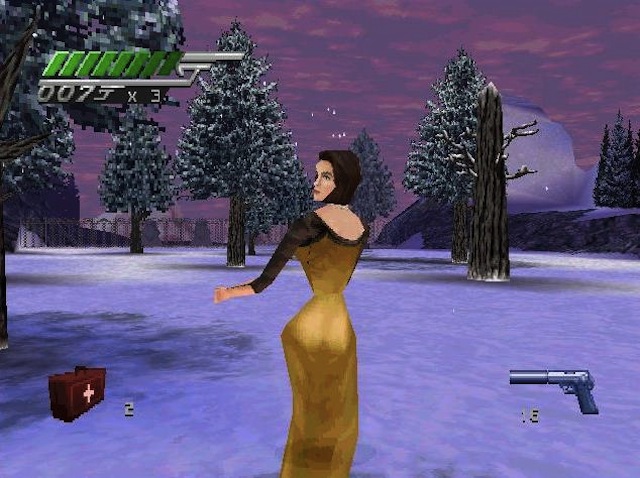
The World Is Not Enough (2000) boasted suprisingly good graphics for a game released in the Nintendo 64 era, and went back to the successful GoldenEye gameplay formula. It stars Pierce Brosnan's James Bond -- his likeness, anyway, but not his voice. Instead, Adam Blackwood voices Bond as he must protect Elektra King (Sophie Marceau. voice of Henrietta Bass) from the evil terrorist Renard (Robert Carlyle, also voiced by Blackwood). But just like in the film, King is working with Renard to blown up Istanbul with a nuclear submarine in order to take over the world's oil market. Bond must team up with Dr. Christmas Jones (Denise Richards, voiced by Caron Pascoe) to stop their plan. John Cleese voices his character of "R." Coming off the failure of Tomorrow Never Dies, it was decided that The World Is Not Enough would go back to its roots as a first-person shooter. In the Nintendo 64 version, it would also see the reintroduction of the multiplayer portion of the game that gave GoldenEye 007 such a lasting appeal. The World is Not Enough allowed you to create scenarios with multiple AI 'bots' as well as your friends. The PlayStation version features 11 single-player levels with two levels of difficulty. However, it does not have a multiplayer mode.
007 Racing (2000) features the voice of John Cleese, now promoted from "R" to "Q." It was developed by Eutechnyx, published by Electronic Arts, and released in 2000 exclusively for the PlayStation console system. This game stars Pierce Brosnan's James Bond -- in likeness but again, not his voice (Adam Blackwood voices James Bond yet again). This game pitted James Bond in his Aston Martin against a high ranking European diplomat and businessman plans to hijack a shipment of NATO weapons and smuggle them to international terrorists inside cars that roll off the assembly line of his automotive plants. Bond's cars include the Aston Martin DB5 from Goldfinger, the Lotus Esprit from The Spy Who Loved Me and For Your Eyes Only, and the BMW Z8 that briefly appeared in The World is not Enough as well as 7 other automobiles. Each car is equipped with all the usual gadgetry and weapons issued by Q. if you get bored playing alone, you can eliminate your opponent in multiplayer missions where you have to destroy the other car, or a game mode called "Pass the Bomb", where you must pass the bomb to the other car by touching it before you blow up. The game which received mediocre reviews on its release and was plagued by bad graphics and unrealistic physics. IGBN said, "EA hits a giant roadblock with this retread, taking the Bond license straight to the junkyard."
James Bond 007: Agent Under Fire (2001) was the fourth Bond game which was not based on a film or book in the James Bond series, following James Bond 007: The Duel, James Bond 007 and EA's own 007 Racing. The game was available for the GameCube, PlayStation 2 and Xbox. In this adventure, CIA agent Zoe Nightshade, a mole in Identicon Corporation, based in Hong Kong, is discovered and captured. Identicon, a botanical research firm, is a possible front for a weapons-smuggling ring. James Bond infiltrates the facility in an attempt to rescue her, as well as retrieve a suspicious courier case in the same building. After freeing Nightshade from a submarine set to launch, the pair flee the facility with the courier case. Nigel Bloch, the head of Identicon, has his forces chase the agents through the streets of Hong Kong. The two steal a second case of vials from a nearby Identicon factory. They then rendezvous with R, who provides Bond with a gadget-laden BMW Z8. A limousine pulls up, as an assassin inside launches a rocket at the agents, killing Zoe, and steals the case. One interesting twist feature is that depending on whether or not the player picks up a verification code, Bond and Zoe are either captured or are taken to the carrier unharmed after having sex on the submarine. In either case, the pair investigate the ship. On the ship they discover the bad guy is cloning world leaders -- copping the plot from the 1967 Casino Royale. Whilst the game was praised by some as offering 'astounding' character models, many felt it too easy and paled in the shadow of GoldenEye, a game that was already four years old. Early advertisements for this game showed the "R" character resembling John Cleese (who had recently appeared as Q's assistant in the film). The final version of the game substitutes a generic-looking character. An EA executive once commented that late licencing issues with Eon Productions lead to Cleese's departure from the game, but the advertising campaign had already been rolled out. This Xbox game has become an infamous because on March 31, 2003, a hacker called Habibi-Xbox used a buffer overflow in the game and became the first to hack into an unmodified X-box. This was part of a $100,000 challenge funded by Lindows founder Michael Robertson.
Nightfire (2002) was a sequel to James Bond 007: Agent Under Fire, published by Electronic Arts. The game was developed by Eurocom for the PlayStation 2, Xbox and Nintendo GameCube video game consoles, Gearbox Software developed the game for Windows, JV Games developed the game for the Game Boy Advance and TransGaming Inc. developed the game alongside Aspyr who published the game for the Mac. The computer versions are substantially different from the console versions, featuring different missions and a modified story line. The game is also the first Bond video game sequel, as it features several characters introduced in the previous game, James Bond 007: Agent Under Fire. It was the first James Bond video game to have its own original theme song, "Nearly Civilized", performed by Canadian trip-hop vocalist Esthero. It also featured a small easter egg relating to the previous game, as in the underwater level the sunken ship has the logo of Malprave industries: the company of the antagonist from Agent Under Fire. It marked Pierce Brosnan's fourth appearance as James Bond before the release of his fourth and final Bond film Die Another Day. His likeness was featured in the game, but not his voice, which was provided by Maxwell Caulfield. This is also the first Bond video game since GoldenEye for which Pierce Brosnan consented to have his image used for that of 007 (in James Bond 007: Agent Under Fire, Bond had an original face somewhat resembling a blend of the facial features of all the actors who had previously played him). The game received more positively than previous EA games, with some reviews calling it the best game in the series since GoldenEye. While not overtly based on a specific book or film, it had similarities with the plot of Moonraker. (Just what the world needs -- a longer version of that movie...)
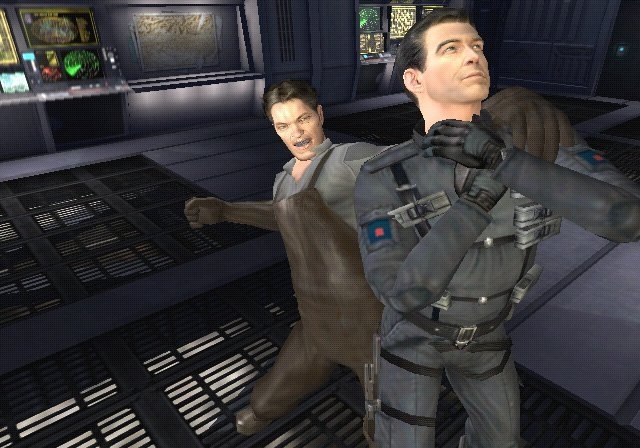
007: Everything or Nothing (2003) is most notable for featuring Pierce Brosnan's likeness and voice as Bond (instead of a hack voiceover guy using a fake British accent, as in previous games), with new and recurring characters in an original movie-style adventure. Supporting Brosnan were Judi Dench (M), and John Cleese (Q) reprising their roles from the film series. The main villian of the game, Nikolai Diavola, is played by Willem Dafoe. His main lieutenant, Katya Nadanova, is played by SI Swimsuit model Heidi Klum...in a skin-tight silver jumpsuit. Shannon Elizabeth (American Pie) plays the newest Bond-girl, and Mýa not only provides the theme song but plays an NSA agent within the game. Richard Kiel even reprises his role as the giant, silver-teethed villain, "Jaws." It also brings back the Aston Martin V12 Vanquish, which was featured in Die Another Day. Most notably. Everything or Nothing also marked Pierce Brosnan's last performance as James Bond in film and in video games.
Everything or Nothing is also the second James Bond video game to have its own original theme song, but the first to be sung by a well-known R&B singer. The singer was Mýa, who also has a part as a Bond girl in the game. In addition, the soundtrack was composed by Sean Callery -- best known for scoring television shows such as Bones, 24 and La Femme Nikita. The soundtrack features a new rendition of the famed James Bond Theme by Callery.
In November of 2004, EA released GoldenEye: Rogue Agent, which attempted to bring GoldenEye 007's success to the PlayStation 2, Xbox, and GameCube. GoldenEye: Rogue Agent was not a remake of GoldenEye but a different beast entirely. Set in an alternate timeline of the James Bond universe, the player takes the role of an ex-MI6 agent Jack Hunter, who is recruited by Auric Goldfinger (a member of a powerful unnamed criminal organisation based on Ian Fleming's SPECTRE) to assassinate his rival Dr. No. Several other characters from the Bond series make appearances throughout the game, including Pussy Galore, Oddjob, Xenia Onatopp and Francisco Scaramanga.
In this setting the game's protagonist is given the name 'GoldenEye' after he loses his eye and receives a gold-colored cybernetic replacement. The story is in no way tied to that of the original movie or game, but it employed a customizable multiplayer mode incorporating online play. Players were cast as an ex-MI6 agent who gets recruited by Goldfinger, and given the eponymous golden eye, in order to take on Dr. No. The game features many other characters from the films and books. Dame Judi Dench is the voice of M, who opens the story by revealing that: "Three years ago, while on assignment, the agent was severely wounded by Dr. No and subsequently lost the use of his right eye. Consumed with vengeance, he frequently resorts to violence and brutality, and is no longer fit for service with MI6." James Bond 007 is the likeness of and voiced by Jason Carter. The game failed critically and in the marketplace. Reviewers disliked its departure from James Bond canon in its introduction and killing off of characters. Due to poor sales, a planned Rogue Agent franchise was canned.
EA then announced they were making a new game, Phoenix Rising, set to be released in 2005. It would star Pierce Brosnan as James Bond, but nothing was ever revealed about the plot (rumours said that it was a follow up to Nightfire with the gameplay elements of Everything or Nothing). But when Brosnan was let go as Bond, all plans for this game were scrapped and replaced with...
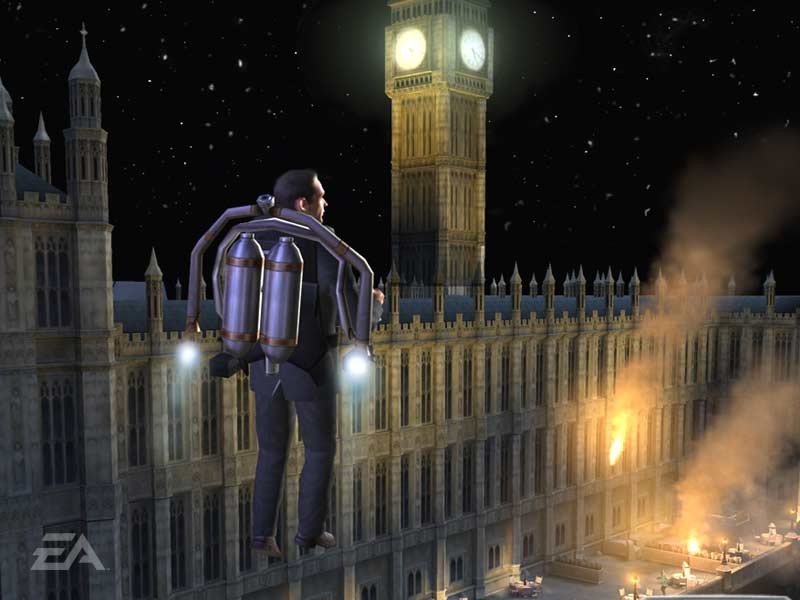
The last James Bond release from EA was a period piece, entitled From Russia With Love. It returned Bond to the sixties, and even included the voice and likeness of Sean Connery. It was a third-person shooter developed by EA Redwood Shores and published by Electronic Arts for the Xbox and PlayStation 2 on November 1, 2005 (and later for the GameCube on November 15, 2005, and then later ported to the PSP on April 3, 2006 by Rebellion). Players reprise the role of suave, swinging-sixties secret agent James Bond (Sean Connery, then in his swinging seventies) as they play through a re-imagining of the 1963 film (based on the 1957 novel).
The main plot of the game involves James Bond undergoing an elaborate theft of a Soviet encoding machine (known as the Lektor) in Turkey with the help of a defecting Soviet agent, Tatiana Romanova. However, they are unaware that they are being manipulated by the global terrorist organization OCTOPUS (named SPECTRE in the movie and novel), mainly from ex-KGB agent Rosa Klebb and her trained assassin, Donald "Red" Grant. In addition the game includes a handful of vehicular combat missions in Bond's icon Aston Martin DB5, (a car that didn't actually debut until Goldfinger), a couple of on-rail shooting segments in which James takes control of a gun turret mounted on the back of a boat, and even a chase on jet packs (which actually appeared in Thunderball).
All of the games in th EA series would be held to the high standard of GoldenEye 007, perhaps unfairly (it's like expecting every Bond film to be as successful as Goldfinger). There were a few critical successes, such as 007: Nightfire and 007: Everything or Nothing. But despite the inclusion of actors from the film series and improved graphics, none of EA's games had the lasting effect on gamers the way GoldenEye 007 did.
Casino Roylale, based on the film of the same name, was to be the next release. Daniel Craig had agreed to star as Bond, giving his voice and likeness in the video game. It was planned for release on PS3 and Xbox 360 platforms, and was 15% developed when the project was cancelled, because Electronic Arts couldn't finish it by the film's release in November 2006. After that, EA's license was not renewed, so to speak.
MGM Interactive then granted Activision the rights to develop and publish games for the James Bond franchise through 2014, shortly after the license was abandoned by Electronic Arts. The results have been spectacular, especially when you look how far the graphics, music, storytelling and overall artistry have come in the games on this page -- in just 25 years!
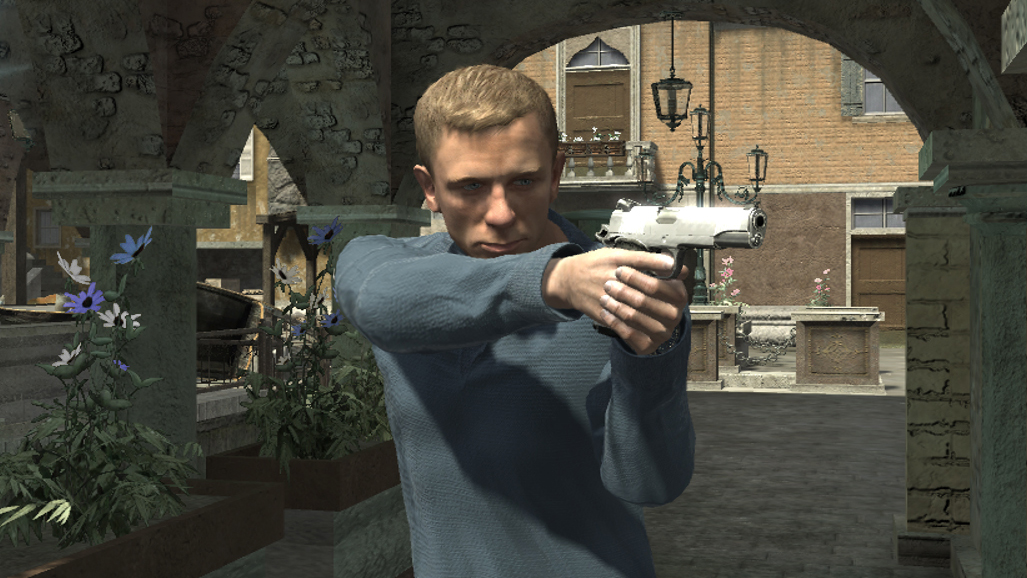
The first game in franchise that they released, 007: Quantum of Solace, brought Bond back to the current day (and the current Bond). Activision's first effort saw Bond's return to the first-person shooter genre was released on on Nov 04, 2008 for multiple platforms to coincide with the release of the film. The game also included the likeness and voice of Daniel Craig, the third Bond actor to provide both for a 007 game, after Brosnan and Connery. He is supported by actors Mathieu Amalric, Mads Mikkelsen, Olga Kurylenko, Judi Dench and Eva Green. The storyfollows immediately from the events of the 2006 film Casino Royale. Opening in Mr. White's Estate, the story follows that of Quantum of Solace loosely, but also flashes back to events from Casino Royale. Other events were created specifically for the game, such as fighting on the roof of the train traveling to Montenegro.
This was followed by GoldenEye 007, a remake of the Rareware game starring Daniel Craig and rewritten to take place in modern times. Originally released just for the Wii, it was ported to the PS3/360 one year later with new controls and high-resolution textures. EON producer Michael G. Wilson spoke in June 2010 about Daniel Craig's participation in revisiting the story from the original film. "When we first pitched the game to him, he was really excited about it. He thought the original game was great. Daniel plays a lot of games and... gives us a lot of good criticism. We'll show him what the plan is and he'll suggest changes and get very hands-on." Wilson went on to say that Craig is aware of the original game's impact, but that his on-screen interpretation of James Bond also required changes to the tone of the story and an increased physical nature to the gameplay. Wilson's son, David Gregg Wilson, is an assistant producer for the James Bond movies and has served as an executive producer on every Bond video game, starting with this one.
Released for the PC/PS3/360 at the same time as the Wii GoldenEye was Blood Stone, a game with an original plot designed by Bizarre Creations that involves bio-weapons, written by none other than Bruce Feirstein, screenwriter of the films GoldenEye and Tomorrow Never Dies. Gameplay was switched back to third-person for this game. The game sees Bond travel around the world on various missions, including preventing a suicide bombing of the G20 at Greece's Acropolis. This third-person shooter takes place after the events of Quantum of Solace and the plot is a mess, but it does try to stay within the universe of Craig's films, with a mysterious organization (Quantum?) replacing SPECTRE. It features the voice and likeness of Daniel Craig as James Bond, Dame Judi Dench as M, and British singer Joss Stone (playing the role of love interest Nicole Hunter). She also performs the game's main theme: I'll Take It All. Unfortunately, it would be the final game released by Bizarre.
The most recent 007 game released by Activision has been 007 Legends, a mish-mash of famous scenes from throughout the franchise, updated to modern times and again starring Daniel Craig. The purpose behind the game is to celebrate fifty years of James Bond in film, and as a video game tie-in to the 2012 film Skyfall (released a month after this game). To achieve this the single player campaign will include one mission from each of the six actors' eras, being Goldfinger (Sean Connery), On Her Majesty's Secret Service (George Lazenby), Moonraker (Roger Moore), Licence To Kill (Timothy Dalton) and Die Another Day (Pierce Brosnan), with Skyfall (Craig). Additionally, some of the original talent from the films are adding their likenesses and voices to their associated characters. 007 Legends was nominated for Outstanding Achievement in Video Game Writing in the Writers Guild of America Awards.
Watching poor Daniel Craig have to strap on a spacesuit and battle Jaws in Moonraker, and then glumly drive an invisible car Die Another Day is interesting, but it makes you wonder: In 20 years, when the technology brings even greater realism, will EON be able to insert the current actor into old Bond movies, too? (I mean, if we still have movies in 20 years.) I hope they don't -- but I do hope we eventually get a 6-way James Bond actor deathmatch like they tried to do in 1997. I'm betting they kill Lazenby first, every time...
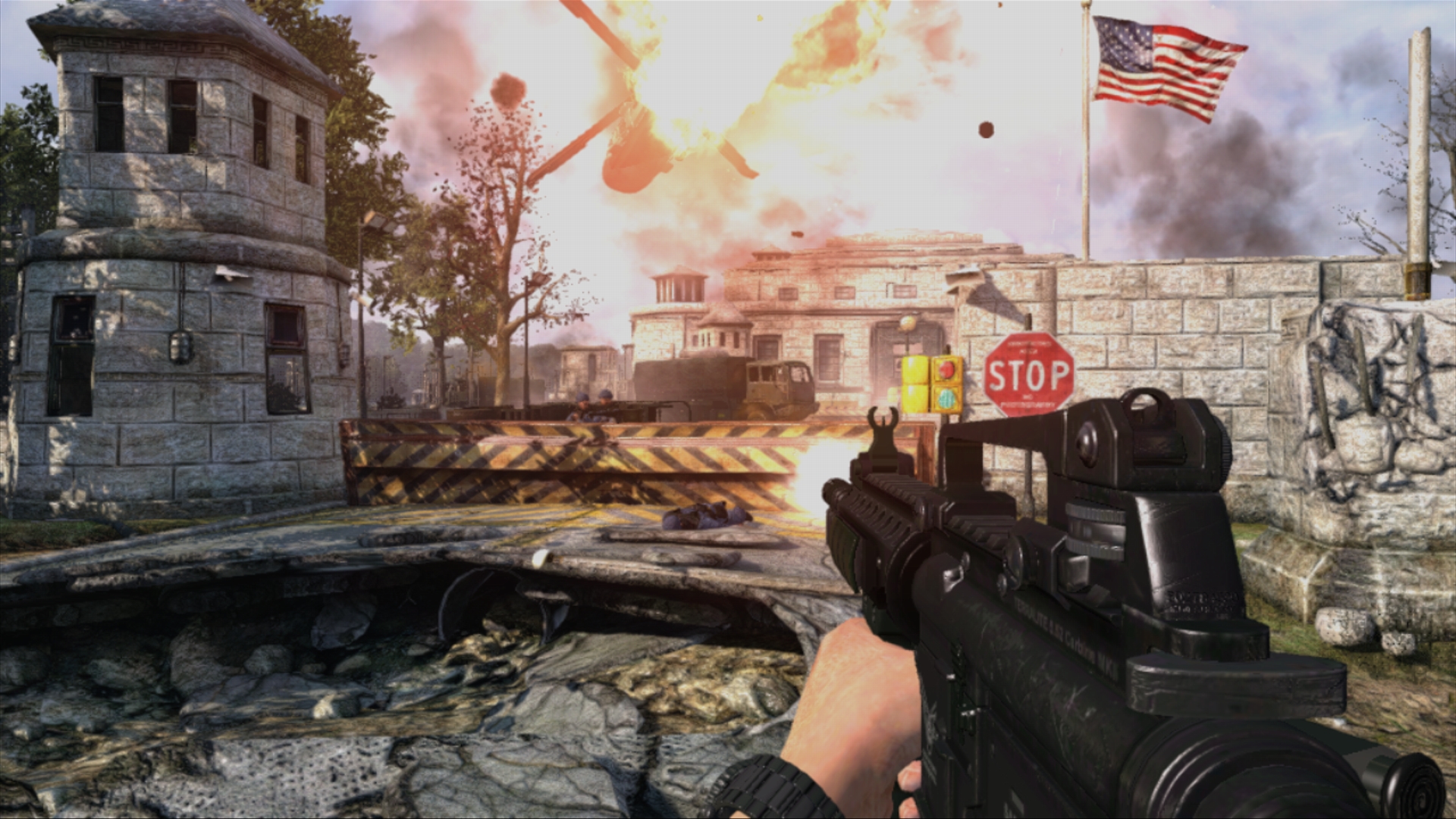
"Hmmm... There appears to be a problem with my side-scrolling Parker Brothers James Bond 007 video game..."
(Top image: the title sequence from "Blood Stone," with the theme song entitled "I'll Take It All," wriiten and performed by Joss Stone and Dave Stewart)
SOURCES:
Building Your James Bond Role Playing Character, by Jim Ciscell (@JimCiscell) on October 5th, 2012.
James Bond: a history in video games
Modern 2 Vintage: A Brief History of James Bond Games
From celluloid to pixels: Movie personalities crash video games
James Bond - The Duel
Good Show, Mr. Bond
50 years of James Bond, three decades of games
Red Grant's Video Game Reviews
The Game's Bond... James Bond -- A History of 007 in Games
Shaken and Stirred: A History of James Bond Games
James Bond on the Amiga
List of cancelled James Bond video games
First Look At Next 007 Game, 7th December 2010 at mi6.
|












